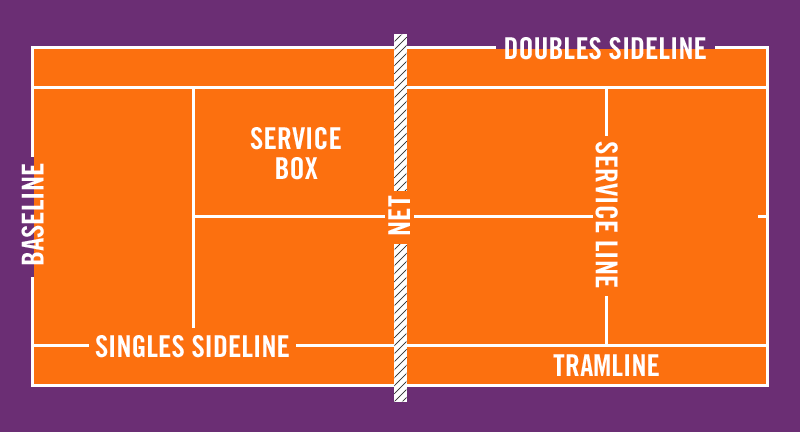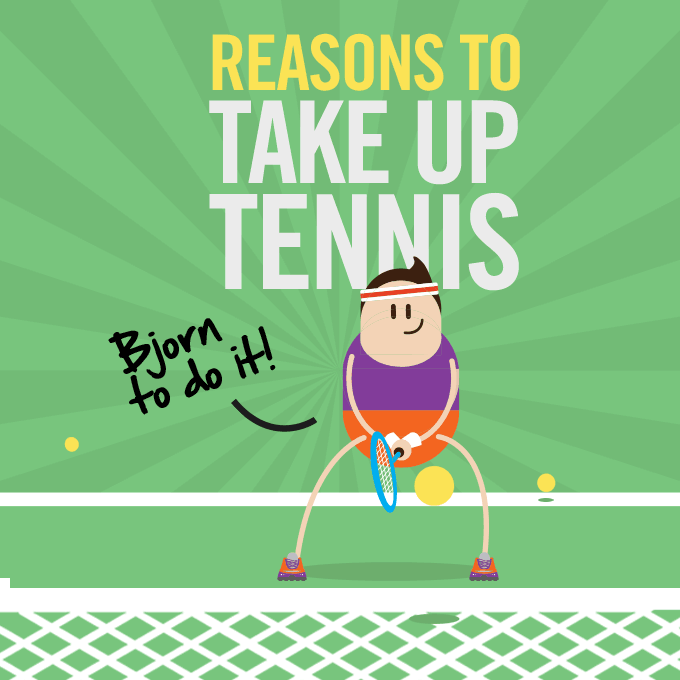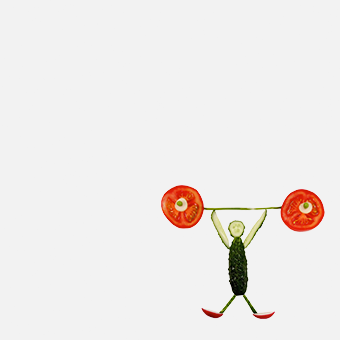What’s 139 years old, lives in South West London and can consume 235,000 glasses of Pimm’s in 2 weeks? Why it’s Wimbledon, of course! Starting on the first week of July every year, the tournament will start, with around 484,000 people flocking to the venue itself, and millions more watching on screens around the world.
Rules of the court
As these statistics suggest, tennis is a hugely popular sport for both players and spectators. Here is our simple outline of the rules:
Tennis is played on a rectangular shaped court, with four types of surface: clay, hard, grass or carpet (Astroturf). A match is played by either two people (singles) or four, with two against two (doubles). When a doubles match is played, the outer sections of the court are used as well, making it 4.5 feet wider. These are known as tramlines.
There are many different styles of shot that you can make in tennis, but the three main ones are forehand, backhand, and serve, which is the starting shot. The players take it in turns to serve, swapping over every new game. With the serving hit, the ball must land in the section diagonally opposite to where the server is standing (service box).
Players stand on either side of the net and have to hit the ball to each other, with a maximum of one bounce with which to return it to their opponent. When a player fails to do this (either because the ball bounces more than once, or it bounces out of the court and over the base or side lines), their opponent will win a point.
There are four points in a game (known as 15, 30, 40 and game point), and the first person to win six games with a lead of two games wins the set. Matches are either the best of three or five sets, depending on how the wins play out. You can remember this order by the famous tennis line: “Game, set and match”. Here are some other tennis terms defined:
Ace
After a serve, when the ball lands in the service box and is not touched by the receiving player before bouncing out of play.
Deuce
In a game, when the points reach 40-40.
Advantage
When a player wins a point after a deuce. They must win again in order to win the game.
Love
A zero score. “15-0” is known as “fifteen-love”.

Anyone for tennis?
Have you ever felt an urge to take to the court? You may aspire to be the next Andy or Rog, but even playing tennis at an amateur level will bring you wonderful benefits.
A tricky one to de-deuce
It’s harder to categorise tennis than other sports, due to the variability of certain factors. One of the main examples of this is the match duration; the shortest match on record was just eighteen minutes long, but by contrast, the longest match in tennis history, which took place at the 2010 Wimbledon Championships between John Isner and Nicolas Mahut, lasted 11 hours and 5 minutes and was played over three days.
Although it’s unlikely that hitting a ball around a court with your mates will ever make it to these extremes, tennis is a sport in which what you get out depends on what you put in. Playing singles, for example, will provide you with more health benefits than doubles, as you’ll be working harder to cover the whole court by yourself.
Anaerobic fitness
Tennis is considered an anaerobic sport. These types of exercises involve short bursts of high-intensity activity, rather than one long, continuous session of a moderate level of exertion. As Bjorn Borg once put it, a tennis match is “a thousand little sprints”.
“Anaerobic” means “without oxygen”, as apposed to “aerobic”, which means “with oxygen”! When we exercise in this way, our heart rate is exerted and our body’s need for oxygen becomes greater than the oxygen available. Therefore, the energy that is stored in the muscles is released, causing lactic acid to be produced as a by-product. If there is too much lactic acid, you’ll find your muscles will get tired, hence why you cannot withstand anaerobic exercise for too long without breaks. There are many benefits associated with anaerobic exercise:
Mighty muscles
By forcing your muscles into these short bouts of high intensity, you will be causing microtears. But don’t worry; this isn’t a bad thing! When your body naturally repairs these tears, it will make the muscles more toned, stronger and larger as well. This will also mean that your joints will be better protected. Tennis will improve muscles and joints all over the body.
Respiratory fitness to the max!
Anaerobic exercises give your VO2 Max a boost. This is the name given to the highest volume of oxygen that your body can consume during exercise.
Forget fatigue
The more your body gets used to exercising in an anaerobic way, the less lactic acid will be produced. This means that your muscles won’t feel tired as quickly and you’ll be able to withstand exercise for longer over time.
In your bones
Tennis is a weight-bearing exercise, and combining this and high intensity will have a positive effect on your bones, increasing their strength and density. This will reverse the effects of osteoporosis. Read our article on bone health here.
Give the grey matter a grand slam
There’s a lot you have to pay attention to in a tennis match. When you’re out there on the court, you’ll have a split second to position yourself so as to not only receive the ball, but also deliver it back with the correct force and angle to keep the ball in play. Then pretty much as soon as you’ve hit it, it’s coming back to you again. Sounds complicated when you put it like that, doesn’t it? Combining all of these quick reaction factors keeps you alert constantly throughout play, and strengthens your brainpower for off the court too. With a complex scoring system, even keeping track of a score from the comfort of your sofa is bound to keep the cogs moving.
Keeping you on your toes
Did you know that during a point, a tennis player may have to change direction as many as five times every ten seconds? By starting, stopping and changing direction hundreds of times during a match, your body will benefit in terms of balance and agility. You will also improve your hand-eye co-ordination more than most other sports, as well as your flexibility, because when on the receiving end of a fast ball, you’ll be likely to have to lunge, reach or stretch for it.
Serving up some self-esteem
A study was carried out at Southern Connecticut State University in which non-athletes were tested in terms of the psychological benefits of different sports. Tennis players scored higher in self-esteem, vigor and optimism, and lower in confusion, tension, anxiety and depression than the competition.
You cannot be serious!
Another survey carried out by Ralph Paffenbarger of Harvard University School of Public Health suggested that if you play tennis at a moderate level for three hours a week, your risk of death from any cause was halved. How’s that for impressive looking odds?
Ride solo or double up
There is a huge amount of discipline that goes into being a tennis player. But if you don’t fancy going it alone, why not team up instead? Team up with a friend, family member or your other half – If you’re really good, why not play doubles with another pair? Just think, you could be the next Williams sisters, or Agassi-Graf. See our article on the successes of being active with a partner.
Now we’ve convinced you that tennis is ace, her are some tips to help you up your game:
Work on your warm up
Think of all that moving that you’ll be doing whilst on court. If your muscles and joints are sufficiently warmed up, you could cause yourself some serious damage. Your warm-up routine should include light jogging, stretches for your arms and lunges for your legs.
Find your perfect match
When choosing someone to play tennis with, make sure that they are your equal in terms of ability. Pushing yourself too fast and too quickly to somebody else’s level will not be beneficial to the progress you make in your playing, and the same goes for limiting yourself if you’re playing with someone who is at a lower ability than you.
Get kitted up
Modern day tennis rackets are made of aluminium or graphite, but they will differ in size. You’ll find mid-size and mid-plus, which are preferred by more advanced players, but beginners may want to opt for an oversized racket when they’re first starting out. But bigger doesn’t always mean better; a very big racket will be much harder to control. The BBC Sport website suggests that a beginner’s racket should weigh 10-11 ounces, which is about the same as a packet of biscuits (finally, a statistic to relate to…!).
Until you’re signed and sponsored by Adidas or Nike, you can have your say on what you wear on court. White clothing is the tradition as it reflects the sun’s rays and is therefore a far cooler option, and you may want to opt for loose clothing for ease of movement.
Although you don’t necessarily need them, there are trainers on the market that are specifically designed to play tennis in, which include special material and reinforcements for your toes, arches and ankles. If you think you might take up tennis on a regular basis, you may like to talk to a sports shoe specialist about these options.
Don’t be fancy, stick to the classics
It might be tempting to try and mess around on the court, trying out some overly clever shots, but you’re more likely to succeed if you practice, perfect and only use a few manoeuvres. Leave the fancy footwork for your celebration once you’ve won the match.
Avoid risky business
It’s very important to learn the key movements first, as playing with an incorrect technique could lead to a repetitive strain injury. Before rushing into matches, make sure you have your forehand and backhand in hand. If you do injure yourself by any means, on or off the court, consult a doctor before continuing to play. This is only likely to make your injury worse.
Harder is not always better
When serving, make sure you’re putting your efforts into your concentration, rather than hitting the ball as hard as possible. Focus will lead to a more accurate shot, and help you reserve your energy too.
Keep hydrated and snack too
As with all sports, hydration is incredibly important, not only to aid your ability but to keep your brain in focus too. Here’s an insider tennis coach tip: drink every time you change over, and have a snack on every other change. Bananas are good to munch on during a match (at Wimbledon they get through 2,100 kilos of them throughout the Championship).



















